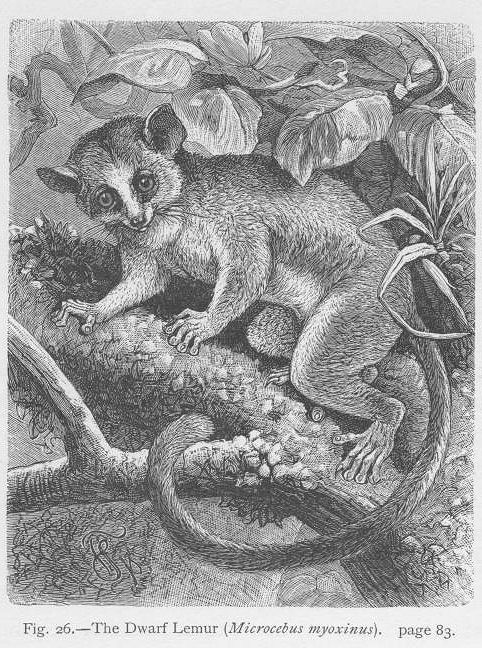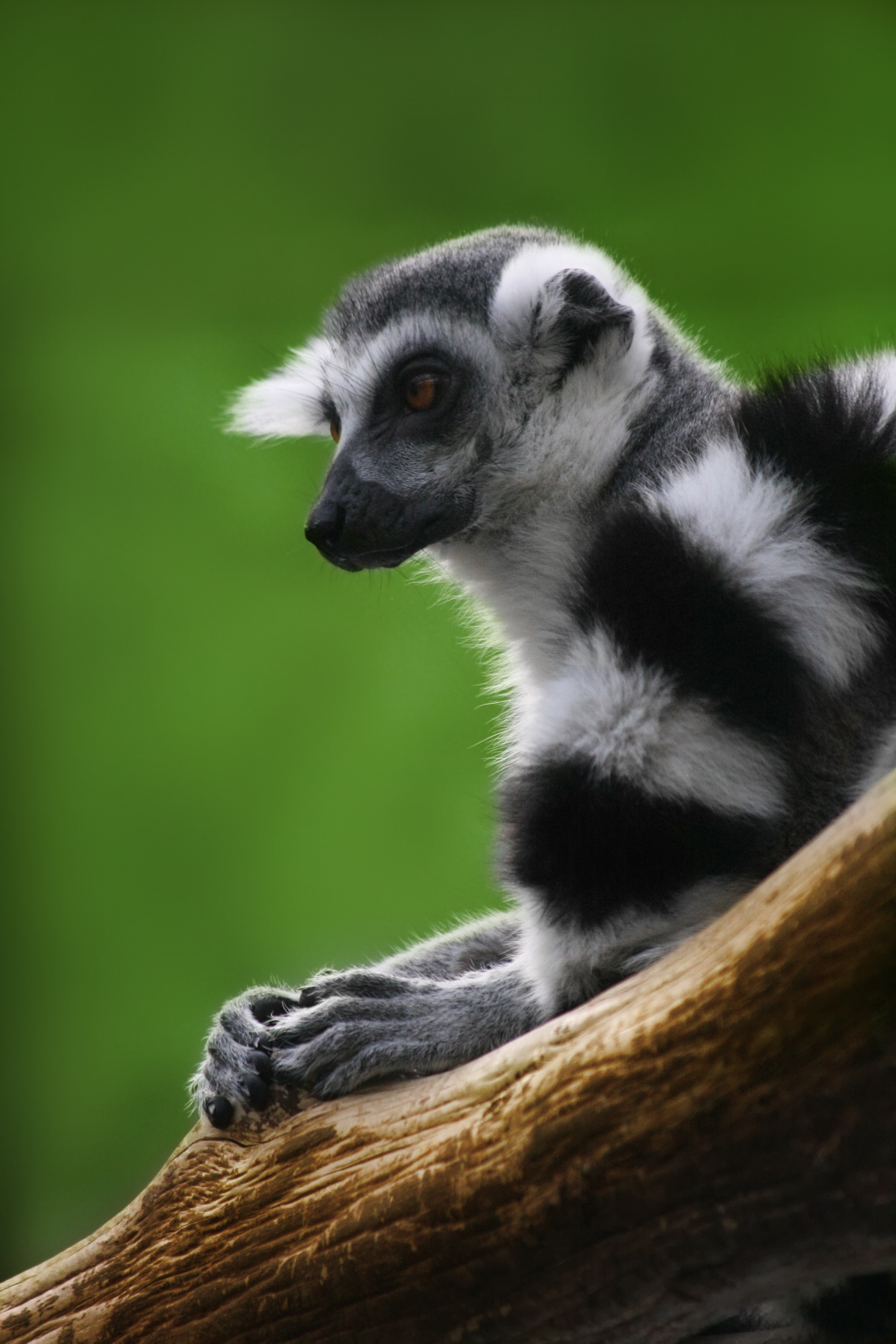|
Dwarf Lemur
The dwarf lemurs are the lemurs of the genus ''Cheirogaleus''. All of the species in this genus, like all other lemurs, are native to Madagascar. Description Measuring 19–27 cm in body length with a tail about 16–17 cm, they are larger than the mouse lemur but smaller than the gentle lemur. Their heads are globular compared to the fox-like heads of the lemurs, but their muzzles are more pointed than those of the hapalemurs. Their hind limbs are slightly longer than their forelimbs, but not as elongated as in lepilemurs or indriids. Dwarf lemurs have an intermembral index of 71 on average. In contrast to most other primates, their grip is similar to that of South American monkeys with objects picked up and branches grasped between the second and third fingers, rather than between the thumb and index finger. Their nails are somewhat keeled and pointed. Dwarf lemurs roam the lower strata of the foliage in the coastal forests of eastern Madagascar. They a ... [...More Info...] [...Related Items...] OR: [Wikipedia] [Google] [Baidu] |
Lavasoa Dwarf Lemur
The Lavasoa dwarf lemur (''Cheirogaleus lavasoensis'') is a small, nocturnal strepsirrhine primate and a species of lemur that is endemic to three small, isolated patches of forest on the southern slopes of the Lavasoa Mountains in southern Madagascar. Fewer than 50 individuals are thought to exist. Its habitat lies in a transitional zone between three ecoregions: dry spiny bush, humid littoral forest, and humid forest. First collected in 2001 and thought to be a subpopulation of the furry-eared dwarf lemur (''C. crossleyi''), it was not formally described until 2013. It is one of six species of dwarf lemur, though the research that identified it also suggested the existence of many more new species. Taxonomic history The Lavasoa dwarf lemur belongs to the genus ''Cheirogaleus'' (dwarf lemurs) within the family Cheirogaleidae. Between October 2001 and December 2006, researchers collected ten mature adults (five male and five female) along with six immature individua ... [...More Info...] [...Related Items...] OR: [Wikipedia] [Google] [Baidu] |
Étienne Geoffroy Saint-Hilaire
Étienne Geoffroy Saint-Hilaire (15 April 177219 June 1844) was a French naturalist who established the principle of "unity of composition". He was a colleague of Jean-Baptiste Lamarck and expanded and defended Lamarck's evolutionary theories. Geoffroy's scientific views had a transcendental flavor (unlike Lamarck's materialistic views) and were similar to those of German morphologists like Lorenz Oken. He believed in the underlying unity of organismal design, and the possibility of the transmutation of species in time, amassing evidence for his claims through research in comparative anatomy, paleontology, and embryology. He is considered as a predecessor of the evo-devo evolutionary concept. Life and early career Geoffroy was born at Étampes (in present-day Essonne), and studied at the Collège de Navarre, in Paris, where he studied natural philosophy under M. J. Brisson. He then attended the lectures of Daubenton at the College de France and Fourcroy at the Jardin des Pl ... [...More Info...] [...Related Items...] OR: [Wikipedia] [Google] [Baidu] |
Mouse Lemur
The mouse lemurs are nocturnal lemurs of the genus ''Microcebus''. Like all lemurs, mouse lemurs are native to Madagascar. Mouse lemurs have a combined head, body and tail length of less than , making them the smallest primates (the smallest species being Madame Berthe's mouse lemur); however, their weight fluctuates in response to daylight duration. Lemurs and mouse lemurs were announced by the IUCN as the most endangered of all vertebrates. There were two known mouse lemur species in 1992; by 2016, there were 24. It was estimated that the 24 mouse lemur species evolved from a common ancestor 10 million years ago. Evolution of mouse lemurs is an example for adaptive radiation. Mouse lemurs are omnivorous; their diets are diverse and include insect secretions, arthropods, small vertebrates, gum, fruit, flowers, nectar, and also leaves and buds depending on the season. Mouse lemurs are considered Species complex, cryptic species—with very little morphological differences betwee ... [...More Info...] [...Related Items...] OR: [Wikipedia] [Google] [Baidu] |
List Of Lemur Species
Lemurs are Strepsirrhini, strepsirrhine primates, all species of which are Endemism, endemic to Madagascar. They include the smallest primate in the world, Madame Berthe's mouse lemur, which weighs , and range up to the size of the indri, which can weigh as much as . However, recently extinct species grew much larger. As of 2010, five Family (biology), families, 15 Genus, genera, and 101 species and subspecies of lemur were formally recognized. From 2000 through 2008, 39 new species were described and nine other taxa resurrected. By 2014, the number of species plus subspecies recognized had increased to 113; of the 105 species then known, the IUCN classified 24 as ... [...More Info...] [...Related Items...] OR: [Wikipedia] [Google] [Baidu] |
Thomas' Dwarf Lemur
The Thomas' dwarf lemur (''Cheirogaleus thomasi'') is a species of dwarf lemur known only from Anosy, Madagascar. It lives in forest A forest is an area of land dominated by trees. Hundreds of definitions of forest are used throughout the world, incorporating factors such as tree density, tree height, land use, legal standing, and ecological function. The United Nations' ...ed regions along the coast. References {{primate-stub Dwarf lemurs Mammals described in 1894 Taxa named by Charles Immanuel Forsyth Major ... [...More Info...] [...Related Items...] OR: [Wikipedia] [Google] [Baidu] |
Torpor
Torpor is a state of decreased physiological activity in an animal, usually marked by a reduced body temperature and metabolic rate. Torpor enables animals to survive periods of reduced food availability. The term "torpor" can refer to the time a hibernator spends at low body temperature, lasting days to weeks, or it can refer to a period of low body temperature and metabolism lasting less than 24 hours, as in "daily torpor". Animals that undergo daily torpor include birds (even tiny hummingbirds, notably Cypselomorphae) and some mammals, including many marsupial species, rodent species (such as mice), and bats. During the active part of their day, such animals maintain normal body temperature and activity levels, but their metabolic rate and body temperature drop during a portion of the day (usually night) to conserve energy. Some animals seasonally go into long periods of inactivity, with reduced body temperature and metabolism, made up of multiple bouts of torpor. This is kno ... [...More Info...] [...Related Items...] OR: [Wikipedia] [Google] [Baidu] |
Quadrupedalism
Quadrupedalism is a form of locomotion where four limbs are used to bear weight and move around. An animal or machine that usually maintains a four-legged posture and moves using all four limbs is said to be a quadruped (from Latin ''quattuor'' for "four", and ''pes'', ''pedis'' for "foot"). Quadruped animals are found among both vertebrates and invertebrates. Quadrupeds vs. tetrapods Although the words ‘quadruped’ and ‘tetrapod’ are both derived from terms meaning ‘four-footed’, they have distinct meanings. A tetrapod is any member of the taxonomic unit Tetrapoda (which is defined by descent from a specific four-limbed ancestor), whereas a quadruped actually uses four limbs for locomotion. Not all tetrapods are quadrupeds and not all entities that could be described as ‘quadrupedal’ are tetrapods. This last meaning includes certain artificial objects; almost all quadruped ''organisms'' are tetrapods (with the exception of some raptorial arthropods adapted fo ... [...More Info...] [...Related Items...] OR: [Wikipedia] [Google] [Baidu] |
Nocturnality
Nocturnality is an animal behavior characterized by being active during the night and sleeping during the day. The common adjective is "nocturnal", versus diurnal meaning the opposite. Nocturnal creatures generally have highly developed senses of hearing, smell, and specially adapted eyesight. Some animals, such as cats and ferrets, have eyes that can adapt to both low-level and bright day levels of illumination (see metaturnal). Others, such as bushbabies and (some) bats, can function only at night. Many nocturnal creatures including tarsiers and some owls have large eyes in comparison with their body size to compensate for the lower light levels at night. More specifically, they have been found to have a larger cornea relative to their eye size than diurnal creatures to increase their : in the low-light conditions. Nocturnality helps wasps, such as ''Apoica flavissima'', avoid hunting in intense sunlight. Diurnal animals, including squirrels and songbirds, are active d ... [...More Info...] [...Related Items...] OR: [Wikipedia] [Google] [Baidu] |
Intermembral Index
The intermembral index is a ratio used to compare limb proportions, expressed as a percentage. It is equal to the length of forelimbs (humerus plus radius) divided by the length of the hind limbs (femur plus tibia) multiplied by 100, otherwise written mathematically as: \tfrac \times 100 The intermembral index is used frequently in primatology, since it helps predict primate locomotor patterns. For scores lower than 100, the forelimbs are shorter than the hind limbs, which is common in leaping primates and bipedal hominids. Quadrupedal primates tend to have scores around 100, while brachiating primates have scores significantly higher than 100. This information can also be used to predict locomotion patterns for extinct primates in cases where forelimb and hind limb fossil A fossil (from Classical Latin , ) is any preserved remains, impression, or trace of any once-living thing from a past geological age. Examples include bones, shells, exoskeletons, stone imprints o ... [...More Info...] [...Related Items...] OR: [Wikipedia] [Google] [Baidu] |
Indriids
The Indriidae (sometimes incorrectly spelled Indridae) are a family of strepsirrhine primates. They are medium- to large-sized lemurs, with only four teeth in the toothcomb instead of the usual six. Indriids, like all lemurs, live exclusively on the island of Madagascar. Classification The 19 living species in the family are divided into three genera. Family Indriidae *Genus ''Indri'' **Indri, ''Indri indri'' *Genus '' Avahi'', woolly lemurs **Bemaraha woolly lemur, ''Avahi cleesei'' **Eastern woolly lemur, ''Avahi laniger'' **Moore's woolly lemur, ''Avahi mooreorum'' **Western woolly lemur, ''Avahi occidentalis'' **Sambirano woolly lemur, ''Avahi unicolor'' **Peyrieras's woolly lemur, ''Avahi peyrierasi'' **Southern woolly lemur, ''Avahi meridionalis'' **Ramanantsoavana's woolly lemur, ''Avahi ramanantsoavani'' **Betsileo woolly lemur, ''Avahi betsileo'' *Genus ''Propithecus'', sifakas **''Propithecus diadema'' group ***Diademed sifaka, ''Propithecus diadema'' ***Silky sifaka ... [...More Info...] [...Related Items...] OR: [Wikipedia] [Google] [Baidu] |
Lepilemur
The sportive lemurs are the medium-sized primates that make up the family Lepilemuridae. The family consists of only one extant genus, ''Lepilemur''. They are closely related to the other lemurs and exclusively live on the island of Madagascar. For a time, this family was named Megaladapidae, but the current name was given precedence since the extinct genus ''Megaladapis'' was removed from the family. Etymology French zoologist Isidore Geoffroy Saint-Hilaire first described the genus ''Lepilemur'' in 1851, prefixing the existing genus ''Lemur'' with the Latin ''lepidus'' ("pleasant" or "pretty"). However, it was erroneously spelled—a mistake later authors unsuccessfully attempted to correct to ''Lepidolemur''. Members of the monogeneric family Lepilemuridae are referred to as either sportive or weasel lemurs. "Sportive lemur", which is more commonly used, was coined by Henry Ogg Forbes in 1894. Though he did not explain the name choice, he did mention the agility of ''Lepilem ... [...More Info...] [...Related Items...] OR: [Wikipedia] [Google] [Baidu] |
Hapalemur
The bamboo lemurs or gentle lemurs are the lemurs in genus ''Hapalemur''. These medium-sized primates live exclusively on Madagascar. Etymology Bamboo lemurs were first described by French zoologist Isidore Geoffroy Saint-Hilaire in 1851. Comparing their small size, proportions, speckled fur, and other traits to those of marmosets—then classified in the genus ''Hapale''—he named the genus ''Hapalemur''. ''Hapale'' derives from the Greek word ἁπαλός (''hapalos''), meaning "gentle". In their discussion of lemur name etymologies, Dunkel ''et al.'' speculated that the once popular vernacular name for the genus, "gentle lemur", derived from the translation of ''Hapalemur'', despite their notoriety for being one of the most aggressive lemurs in captivity—an observation first noted in a letter by Dutch naturalist François Pollen published in 1895. More recently, the common name "bamboo lemur" first appeared in the mid- to late-1980s following the rediscovery of the great ... [...More Info...] [...Related Items...] OR: [Wikipedia] [Google] [Baidu] |



